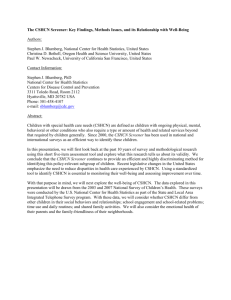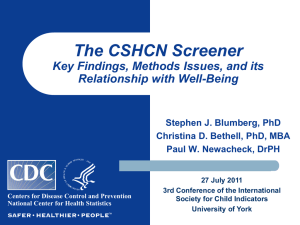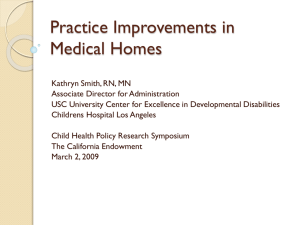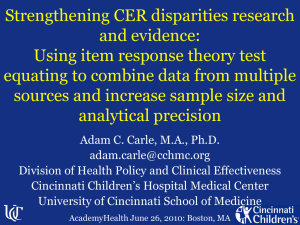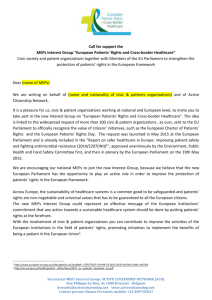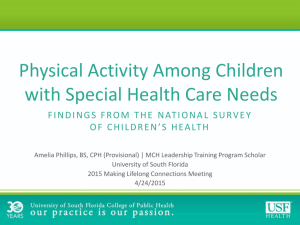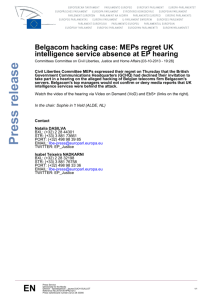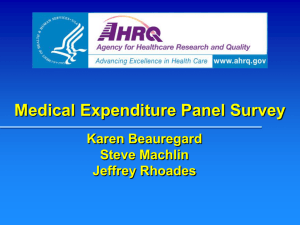Comparing and interpreting findings on the
advertisement
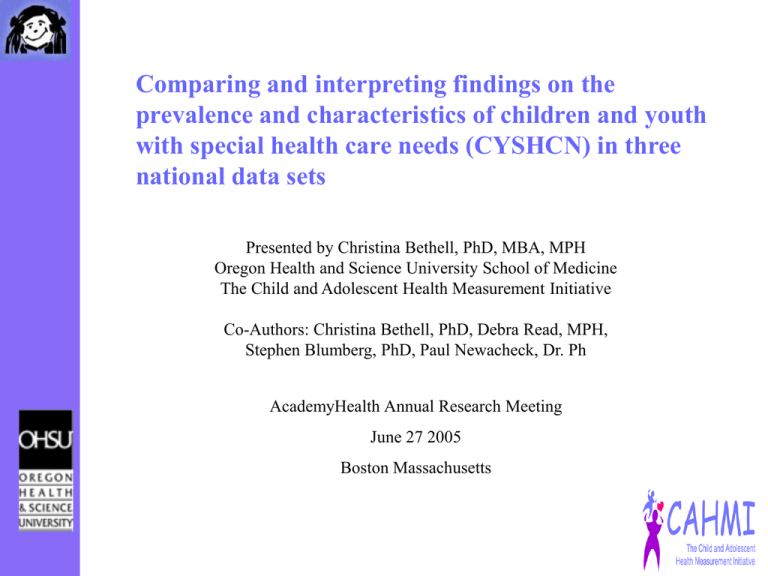
Comparing and interpreting findings on the prevalence and characteristics of children and youth with special health care needs (CYSHCN) in three national data sets Presented by Christina Bethell, PhD, MBA, MPH Oregon Health and Science University School of Medicine The Child and Adolescent Health Measurement Initiative Co-Authors: Christina Bethell, PhD, Debra Read, MPH, Stephen Blumberg, PhD, Paul Newacheck, Dr. Ph AcademyHealth Annual Research Meeting June 27 2005 Boston Massachusetts Purpose • To describe variations in prevalence and characteristics of children and youth with special health care needs across three national surveys that used the same identification method (CSHCN Screener) 1. 2. 3. • National Survey of Children with Special Health Care Needs (2001) Medical Expenditures Panel Survey (2000 and 2002) National Survey of Children’s Health (2003) Explore survey methodology and real changes in prevalence and/or practice patterns across survey years that may account for observed differences CSHCN Screener • Developed to operationalize the federal MCHB definition of CYSHCN • “Children with special health care needs are children who have or are at risk for a chronic physical, developmental, behavioral, or emotional condition and who also require health and related services of a type or amount beyond that required by children generally.” CSHCN Screener • Five item consequences-based, parent reported screening tool that is not based on a condition check-list or ICD-9/10 diagnostic codes • Identifies children and youth who currently experience one or more of five health or health need consequences due to an ongoing health condition. • • • • • Current use of RX meds for ongoing condition Above routine use of medical, mental or other type of health services for ongoing condition Need or use specialized therapies for ongoing condition Need or use treatment or counseling for an ongoing emotional, developmental or behavioral health condition Functional difficulties/problem doing things other children his/her age can do due to ongoing condition Analytic Methods 1. Qualitative comparison of the design, sampling and administration of NS-CSHCN, NSCH and MEPS 2. Compare CSHCN Identification Rates – – – 3. Overall and by demographic subgroups of children By CSHCN Screener qualifying criteria and number of criteria met By type of health and health need consequences experienced by CSHCN once they are identified Probability of Identification Across Surveys • • Logistic regression to assess association between identification and demographic factors Adjusted odds ratios calculated for age, sex, race/ethnicity, household income Analytic Methods 4. CSHCN Screener Administration “Anchoring” Differences Between 2001 NS-CSHCN and MEPS 2000 – Compare NS-CSHCN rates for only households with one child to MEPS 2000 in order to isolate the potential impact of difference in CSHCN Screener applications • • NS-CSHCN--all children in household screened simultaneously, no priming questions on child’s health MEPS 2000--all children in household screened separately, no priming questions on child’s health Analytic Methods 5. Impact of Practice Pattern Changes – CSHCN increase between 2000 and 2002 MEPS largely driven by increased identification on Q1: Current use of RX meds for ongoing condition. – We confirmed whether there was also an increase in documented RX meds between 2000 and 2002-especially “chronic” use (5 or more RX meds/refills in a year). • • Validity check for the CSHCN Screener May indicate real increases in treatment of chronic conditions with prescription medications between 2000 and 2002 Results: Methods Comparison Summary of Key Methods Differences • Sampling – All children in household (NS-CSHCN and MEPS) vs. target child (NSCH) – Random digit dial/SLAITS (NS-CSHCN and NSCH) vs. panel design/NHIS (MEPS) – NS-CSHCN and NSCH sampled to allow for state level estimates. MEPS does not allow state estimates to be made. • Mode – Mail (MEPS 2000) – CATI (NS-CSHCN and NSCH) – CAPI (MEPS 2002) Results: Methods Comparison Summary of Key Methods Differences • Survey Design and Administration – Question order differed between NS-CSHCN and NSCH and MEPS – Incentives used for NSCH and not NS-CSHCN or MEPS – Preceding survey items about child’s health for MEPS 2002 (5 items) and NS-CH (3 items) and not NS-CSHCN or MEPS 2000 – Screening approach was simultaneous for NS-CSHCN and was conducted for each child separately for MEPS and NSCH – Overall framing for screening • NS-CSHCN: screen and then survey (“If yes, then longer survey”) • NSCH: screening in context of survey • MEPS 2000: Screening conducted in context of longer mailed survey on child’s health care • MEPS 2002: screener part of much longer survey on adult and child health Results: CSHCN Identification Rates • Total Children Screened – – – – NS-CSHCN 2001 -372,174 children age 0-17 MEPS 2000 - 6418 children age 0-17 at end of survey year MEPS 2002 - 11,490 children age 0-17 NSCH 2003 - 102,353 children age 0-17 • CSHCN Identified – – – – 2001 NS-CSHCN – 12.8% -- 48,690 children MEPS 2000 – 16.2% -- 956 children MEPS 2002 – 19.4% -- 2096 children 2003 NSCH – 17.6% -- 18,561 children Results: CSHCN Identification Rates by Child and Family Characteristics? Category All Children By Age By Sex By Race/Ethnicity By HH Income NS-CSHCN vs. MEPS and NSCH 13 MEPS 2002 vs.2003 of 15 possible NSCH 2 of 15 differences possible differences Yes, NS-CSHCN Lower No NS-CSHCN Lower All MEPS higher 12-17 Groups age only NS-CSHCN Lower All Groups No NS-CSHCN Lower White, Black, MEPS slightly higher Hispanic White only NS-CSHCN Lower All Groups No Results: Probability of Identification by Demographic Groups • While rates are lower for NS-CSHCN, the probability of identification according to age, sex, race/ethnicity and household income is largely stable across all three surveys (less than .5 AOR differences across surveys) – Age (vs. age 0-5) • 6-11: 2.03-2.21 Adjusted Odds Ratios (sig) • 12-17: 2.17-2.57 Adjusted Odds Ratios (sig) – Sex (vs. male) • Female: .66-.76 Adjusted Odds Ratios (sig) Results: Probability of Identification by Demographic Groups – Race (vs. White) • Hispanic: .78-.87 Adjusted Odds Ratios (sig. for all but MEPS 2002) • Black: .83-.88 (nearly sig) – Income (vs. 400% + FPL) • 0-99%: 1.00-1.47 AOR (sig NS-CSHCN only) • 100-199%: 1.06-1.20 AOR (sig NS-CSHCN only) • 200-399%: .92-.95 AOR (not sig) Results: Do CSHCN Identification Rates Differ Significantly By Proportion Identified for Each Qualifying Criteria CSHCN Qualifying Criteria 2001 NS-CSHCN vs. MEPS 2002 and 2003 NSCH Q1: RX Meds Q2: Elevated Service Need/Use Q3: Functional Limitations MEPS 2002 vs. 2003 NSCH No (MEPS near sig. 1.2% higher) No Yes, NS-CSHCN lower Q4: Specialized Therapies No No (MEPS near sig. .5% higher) Q5: Trt/Counseling for Emot., Behav., Develp. Problem No (MEPS near sig. .6% higher) CSHCN Identification Rate By CSHCN Screener Qualifying Criteria • Rank of the probability of identification by CSHCN Screener question is the same across all three surveys – – – – – Q1 – most likely (RX meds) Q2 – 2nd most likely (elevated need/use) Q5: - 3rd most likely (trt for emot., devel., behav. problem) Q3: -4th most likely (functional limitations) Q4 – least likely (specialized therapies) Summary of CSHCN Identification Rate By Child Characteristics, Qualifying Criteria, and Number and Type of Consequences • Virtually all significant differences in rates of identification by demographic characteristics, qualifying criteria and number or type consequences are accounted for by lower rates on NS-CSHCN. • While rates for NS-CSHCN are lower, conclusions regarding the probability of identification as CSHCN remain largely stable across all surveys • NSCH and MEPS 2002 do not differ significantly in nearly all cases evaluated. • When NSCH and MEPS 2002 are different, MEPS 2002 is ALWAYS just slightly higher (possible conditioning and priming effects?) Summary of CSHCN Identification Rate By Child Characteristics, Qualifying Criteria, and Number and Type of Consequences • Once identified, we do not observe any significant differences in proportion identified by number of qualifying criteria across surveys • Once, identified, we observe that CSHCN identified across all three surveys have the same likelihood of experiencing functional limitations • Once identified, we do observe that CSHCN identified via the NS-CSHCN – are slightly more likely to have an elevated need or use for services AND need/use of RX meds (complexity higher?) – are slightly less likely to have need or use of RX meds as their ONLY health or health care need consequence Testing the “Anchoring” Hypothesis by Comparing 2001 NS-CSHCN Rates for Single Child Households to MEPS 2000 • Comparison to MEPS 2000 selected as a comparison to 2001 NSCSHCN because – a substantial proportion of NS-CSHCN data was collected in 2000 – MEPS 2000 did not include health related priming questions (did include health care use questions, however) – MEPS 2000 (vs. MEPS 2002) child survey was conducted separate from large adult and child household survey making it more similar to NS-CSHCN in this regard • NS-CSHCN subset to single child households to remove the “comparing your children” effect of simultaneous (all children at once) CSHCN Screener administration – MEPS 2000 provided a separate survey for each child in the household Result: Statistical Difference Between 2001 NSCSHCN and MEPS 2000 Nearly Eliminated Overall Rate Q1: RX Meds Q2: Elevated Service Need/Use Q3: Functional Limitations Q4: Specialized Therapies Q5: Trt/Counseling for Emot., Behav., Develp. Problem 2001 NS-CSHCN Single Child Households Only MEPS 2000 14.2 (13.8-14.6) 16.2 (14.7-17.7) 11% (10.7-11.4) 11.8% (10.8-12.9) 6.3% (6.1-6.6) 6.8% (6.0-7.7) 3.4% (3.2-3.6) 4% (3.2-5.0) 2.2% (2.0-2.4) 3.2% (2.7-3.8) 3.9% (3.7-4.1) 6.2% (5.2-7.3) Assessing Practice Pattern Changes Between Survey Years as Explanation for Increased CSCHN Rates • Compare MEPS 2000 and MEPS 2002 – Same sampling frame and same survey – Objective data on the count and names of prescription medications children taken is available for both years • CSHCN identification rates up 3.1% points – MEPS 2000: 16.2% – MEPS 2002: 19.4% (increase entirely in 6-11 age group) • 81.3% of the increase is accounted for by increased identification on Q1: Current use of prescription medications for an ongoing condition – 2.6 point increase in population identification on Q1 between 2000 and 2002 Assessing Practice Pattern Changes Between Survey Years as Explanation for Increased CSCHN Rates • Increase in RX Meds use 2000-2002 – All Children: 3.5 point increase in ANY RX Meds (49.7 to 53.3%) – CSHCN: 6 point increase in ANY RX Meds (78.884.8%) – Non-CSHCN: .1 point increase in ANY RX Meds (not sig) • Increase virtually entirely accounted for by CYSHCN Assessing Practice Pattern Changes Between Survey Years as Explanation for Increased CSCHN Rates • 75% of increase in RX Meds accounted for by an increase in “5 or more medications/refills”. – .9% increase in children/youth with 1-4 medications/refills – 2.6% increase in children/youth with 5 or more medications/refills • Increase disproportionately accounted for by CYSCHN age 12-17. – 37% increase in 5+ RX Meds use (13.9-17.3 points) between 2000 and 2002 vs. 4.1-6.5 points for the younger age groups. Conclusions CSHCN Screener is picking up what appear to be real practice pattern changes between 2000 and 2002 • Probability of identification using the CSHCN Screener is dramatically higher for children and youth with 5 or more medications/refills in a year period • The CSHCN Screener discriminates use of RX Meds for acute vs. ongoing conditions – 37% with five or more medications/refills do not qualify as CYSHCN due to a “no” response to the “duration of condition” follow up item. Conclusions CSHCN Screener is picking up what appear to be real practice pattern changes between 2000 and 2002 MEPS 2000 (Adjusted # RX Med Verified Odds Ratio; Versus 0 as Filled RX Meds) MEPS 2002 (Adjusted Odds Ratio; Versus 0 RX Meds) 1.93 (1.5-2.5) 2.81 (2.3-3.4) 4.48 (3.3-6.1) 7.38 (5.9-9.2) 18.0 (13.6-23.8) 32.7 (26.2-40.9) 1-2 Meds/Refills 3-4 Meds/Refills 5 or more Meds/Refills Conclusions Association Between Chronic RX Meds Use and CSCHN Identification is Strong (MEPS 2002) % Qualifying # RX Med % Qualifying on Q1 of Verified as As CSHCN CSHCN Filled Screener 0 6.3% 2.0% 1-2 filled 14.0% 9.0% 3-4 filled 5 or more filled 27.6% 20.4% 63.1% 58.4% Conclusions Increased Use of RX Meds Appears to Be for Treatment of Chronic Conditions – especially among youth age 12-17 • Several factors suggest that the increased use of RX Meds is for chronic health problems – Association between use of RX Meds and identification using the CSHCN Screener is stronger for 2002 than for 2000 – Increases in RX Meds use between 2000 and 2002 is largely for 5 or more medications/refills • Findings suggest that – The majority of the observed increase in CSHCN over time is for children who have a chronic use of medications (5 or more medications/refills in a year period) – The majority of the increase in children and youth with 5 or more medications/refills in a year period is accounted for by youth age 12-17 Limitations and Next Steps • Each survey evaluated is designed to produce national population-based estimates. However, their use of a different sampling and administration method results in limited “apples to apples” comparison opportunities. • Further analysis is required to determine the class of drugs and specific chronic health issues driving the increased identification on Q1/RX Meds – Based on other research, we hypothesize the increase is significantly driven by increased use of medications for mental, emotional and behavioral problems in youth age 1217 • Consideration of other issues and explanations as well as policy and program implications is underway.
